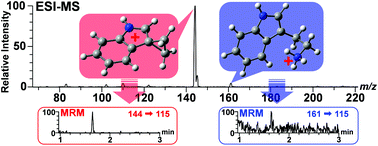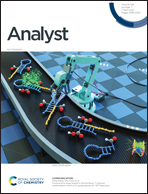Fragmentation study of tryptophan-derived metabolites induced by electrospray ionization mass spectrometry for highly sensitive analysis†
Abstract
Liquid chromatography–tandem mass spectrometry (LC–MS/MS) is interfaced with electrospray ionization (ESI), which generally produces intact gas-phase ions of biomolecules. However, ESI induces the fragmentation of tryptophan-derived metabolites, which are known to act as neurotransmitters and psychoactive drugs. Tryptophan-derived metabolites undergo N–Cα bond dissociation during ESI, producing a fragment ion with a spiro[cyclopropane-indolium] backbone. Fragmentation is suppressed by the presence of an α-carboxyl group and the modification of amino groups. In particular, tryptamine and serotonin, which lack such functional groups, produce more intense fragment-ion signals than protonated molecules. The multiple reaction monitoring (MRM)-based quantitative analysis of tryptamine and serotonin used the fragment ions produced from in-source collision-induced dissociation as the precursor ions, which improved the signal-to-noise ratio of the resulting spectra. The present method allows for the quantitative analysis of tryptamine and serotonin with high sensitivity.



 Please wait while we load your content...
Please wait while we load your content...